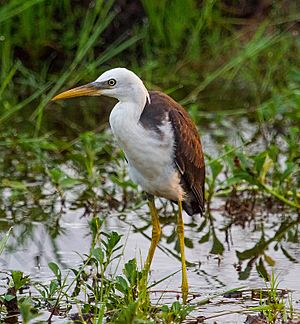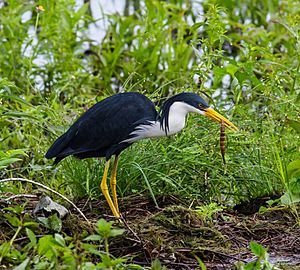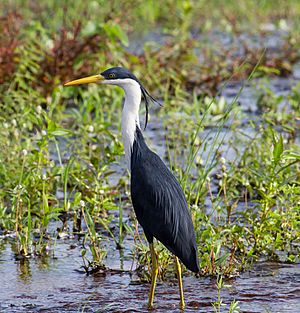Pied heron facts for kids
Quick facts for kids Pied heron |
|
|---|---|
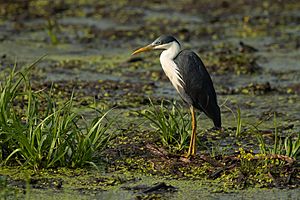 |
|
| Conservation status | |
| Scientific classification | |
| Genus: |
Egretta
|
| Species: |
picata
|
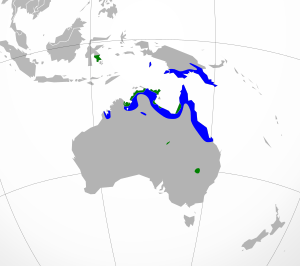 |
|
| Distribution. Green: year-round breeding, blue: nonbreeding. | |
| Synonyms | |
|
|
The pied heron (Egretta picata), also known as the pied egret, is a cool bird. You can find it in wet, coastal areas of northern Australia. It also lives in parts of Wallacea and New Guinea.
Contents
Understanding the Pied Heron's Family Tree
A famous bird expert named John Gould first described this bird in 1845. Scientists who study how living things are grouped, called taxonomists, now place this bird in the Egretta family. This family includes many types of egrets. There are no different kinds or subspecies of the pied heron known today.
What Does the Pied Heron Look Like?
The pied heron is a small bird, about 43 to 55 centimeters (17 to 22 inches) long. Its wings, body, and the top of its head are a dark, slate-gray color. It has a cool crest of feathers on its head. Its throat and neck are bright white.
This bird looks a bit like the white-necked heron. Male pied herons are a little heavier than females. Males weigh about 247 to 280 grams (8.7 to 9.9 ounces). Females weigh around 225 to 242 grams (7.9 to 8.5 ounces). Even though they are different weights, males and females look very similar.
Young pied herons, called juveniles, look a bit different. They do not have the crest on their heads. Their heads also lack the dark coloring of the adults. Because of this, young pied herons used to be thought of as a completely different species!
Where Do Pied Herons Live?
Pied herons mostly live in wetlands and wet grasslands. These are places like swamps, marshes, and areas with lots of water. They love places where it's easy to find food and build nests near water.
Pied Heron Behavior and Habits
How Pied Herons Communicate
When a pied heron flies, it often makes a loud 'awk' or 'ohrk' sound. This is its main call. When they are around their nests, they make softer cooing sounds. Scientists are still learning more about all the different sounds these birds make.
Pied Heron Reproduction and Life Cycle
Pied herons usually have their babies between February and May. They build their nests in trees that are above water. This includes trees like mangroves. They often build their nests in groups, or colonies, with other types of herons.
Their nests are shallow platforms made of sticks. The female bird lays one or two eggs. These eggs are a pretty blue-green color.
What Do Pied Herons Eat?
Pied herons eat a variety of small animals. Their diet includes insects, frogs, crabs, and fish. They also eat other small creatures that live in or near water. Insects are a very important part of their diet.
These birds can hunt for food alone. But sometimes, you might see them feeding in very large groups. These groups can have up to a thousand birds!
See also
 In Spanish: Garceta pía para niños
In Spanish: Garceta pía para niños



